
As i was re reading tartine bread the other week in preparation for my last post i realized just how important managing your sourdough starter fermentation is after i stumbled on this quote. Bread made with 100 rye flour is usually obtained by sourdough fermentation.

As i was re reading tartine bread the other week in preparation for my last post i realized just how important managing your sourdough starter fermentation is after i stumbled on this quote.
Fermentation of sourdough bread. We ve already covered and defined fermentation as a general concept in sourdough starters. Microorganisms yeast and lactic acid bacteria break down starches to produce carbon dioxide gas and sour flavors. For breads proper fermentation maximizes the potential for effective expansion and trapping of gases in a well developed gluten matrix.
Fermented sourdough bread can often be tolerated by those with gluten sensitivities and can be a good first bread to try after you ve been avoiding grains for a long period of time. The process of slow fermentation allows the bacteria to break down the carbohydrates and gluten and also neutralizes the phytic acid making it easier for the body to digest. A levain is a preferment used to make sourdough bread composed of a mix of water and flour that is fermented by lactic acid bacteria lab and wild yeast.
By themselves the raw ingredients that go into a sourdough are essentially flavorless. Fermentation of sourdough bread. Sourdough bread is made from a sourdough starter levain.
A starter is created by adding water and flour together to make a sponge which is left to ferment. The following day more flour and water is fed to the starter. Residual sourdough is used to make a liquid ferment for steamed bread production.
The sourdough is soaked and dispersed in warm water before being mixed into a slurry with flour and yeast. The slurry is then fermented for 3 4 h at 25 30 c before use. 6 5 4 2 liquid ferment dough preparation.
Sourdough bread is made by a process of fermentation using naturally occurring lactobacilli and yeast. Lactic acid fermentation and alcoholic fermentation occur in sourdough bread. The pyruvate produced for glycolysis are the substrates for lactic acid and alcoholic fermentation.
As i was re reading tartine bread the other week in preparation for my last post i realized just how important managing your sourdough starter fermentation is after i stumbled on this quote. A baker s true skill lies in the way he or she manages fermentation. This is the soul of bread making.
I think sometimes it s easy for me to fall into the routine of blindly feeding my. Long fermentation advantages the sourdough has more time to work on the bran of the grain breaking it down to make it more digestible and neutralizing phytic acid. Sourdough starter imparts a depth of flavor that cannot be found with just a small addition of sourdough to a bread that uses baking soda for leavening.
Bread made with 100 rye flour is usually obtained by sourdough fermentation. The acidity of sourdough inactivates α amylases commonly present in rye flour thus preventing excessive starch degradation and it promotes solubilization of rye pentosans that enhance the water binding capacity of the dough allowing the starch to gel and form a matrix during cooking. Sourdough bread has a relatively low glycemic index compared with other types of bread.
The activity of cereal enzymes during sourdough fermentation hydrolyses phytates which affect the absorption of some dietary minerals. Sourdough bread made from whole grains was recommended as a key daily food in the italian mediterranean diet.